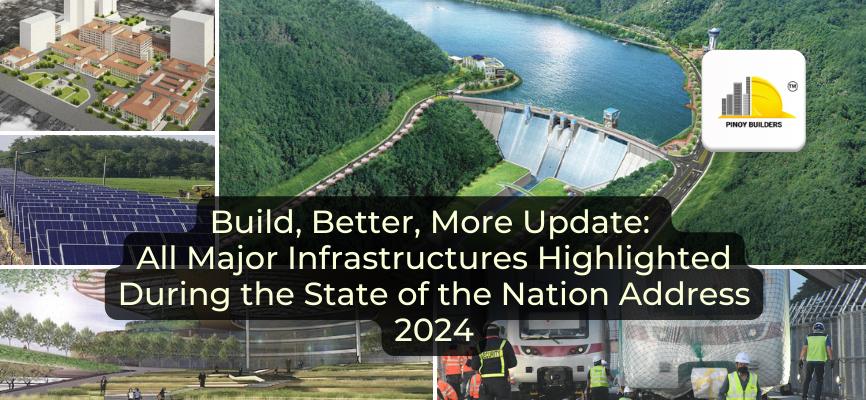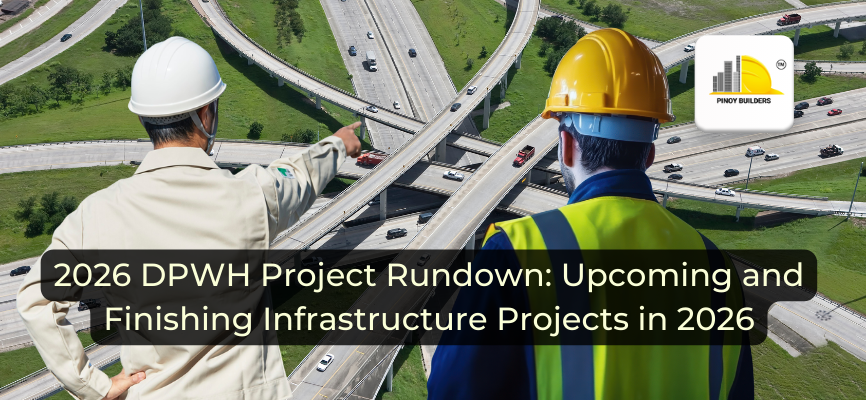QUEZON CITY, Philippines – On July 22, 2024, President Marcos Jr. delivered his third State of the Nation Address (SONA), outlining his administration’s progress and goals for the Philippines. Held in Batasang Pambansa Complex, the president emphasized the administration’s commitment to the “Build, Better, More” initiative. He also highlighted key infrastructure projects to drive economic growth and improve living standards nationwide.
The address placed importance on infrastructure development, regional connectivity, and public service enhancements. In his opening remarks, he stressed the importance of continued financial investment in national objectives, one being infrastructure to sustain economic momentum and improve public welfare.
Major Infrastructure Projects Highlighted During SONA 2024
Transportation Projects
The President announced significant progress in transportation infrastructure, including new highways, railways, and airport expansions. These projects are expected to enhance regional connectivity and spur economic growth by facilitating easier movement of goods and people. Below are some of the projects highlighted during SONA 2024:
1. Pangui Bay Bridge

Projected to be the longest-spanning water bridge in Mindanao, the Panguil Bay Bridge is a 3.77 km extradosed bridge that will cross Panguil Bay and connect Tangub in Misamis Occidental and Tubod in Lanao del Norte.
2. New Clark City Access Road

The New Clark Cty Access Road, also known as ANAR, is a 19.81-kilometer, toll-free, six-lane highway that will cut travel time from other districts of Clark to New Clark City to about 20 minutes from an hour.
3. Metro Rail Transit Line 7

Also known as MRT Line 7 or MRT-7, this project will complete a rapid transit line that will be 22.8 kilometers long. MRT-7 will have 14 stations running in a northeast-southwest direction, beginning at San Jose del Monte, Bulacan, and ending at the North Triangle Common Station in North Avenue, Quezon City. It will be the first line to have a third rail electrification in the country.
4. LRT-1 Cavite Extension Project

The Cavite Extension project will increase the number of LRT-1 stations from 20 to 28, covering major cities like Quezon City, Caloocan, Manila, Pasay, Paranaque, and Bacoor, Cavite. It will add 11 km to the railway system, servicing up to 800,000 passengers daily. This extension is expected to boost commercial development around the rail stations.
5. North-South Commuter Railway (NSCR)

Also known as the Clark–Calamba Railway, the NSCR is a 147-kilometer commuter rail system. Once completed, the NSCR will run from New Clark City in Capas, Tarlac, to Calamba, Laguna, with 36 stations.
6. Ninoy Aquino International Airport (NAIA) Rehabilitation Project

The NAIA upgrade project involves rehabilitating passenger terminals and airside facilities like runways, parking areas, and lighting, and adding features for intermodal transfers. The upgrade aims to boost NAIA’s capacity from 35 to 62 million passengers annually and increase air traffic movements from 40 to 48 per hour.
President Ferdinand Marcos Jr. also noted the following:
- 12km worth of roads and more than 1200 bridges have been built and upgraded as of May 2024.
- A budget has been made to upgrade 1600 km of roads for the Maharlika Highway connecting the three major islands of the country.
- 76 new trains have been added to the Light Railway Transit Line 1 (LRT -1) to improve the commuter experience.
- PNR Bicol Line which runs from Naga City in Camarines Sur to Legazpi City in Albay has been opened once again to the public.
Public Utility and Service Infrastructure Projects
Key updates were provided on public utility projects such as water supply, electricity, and internet connectivity. According to President Marcos Jr., the country’s internet connectivity is lacking, highlighting the essential collaboration with the private sector to deliver the service to those who still lack access to the necessary services.
“As of 2022, only seventy-seven percent or 20.6 million households were connected to the Internet. This is much too low,” he said. “Together with our private sector partners, we will efficiently harness the concept of common towers to provide connectivity to Filipinos who are at the far end of the last mile.”
These improvements aim to ensure reliable service delivery and greater accessibility, particularly in underserved areas. Below are the projects mentioned during the SONA:
1. Mariveles-Hermosa-San Jose transmission line

Also known as MHSJ, the project includes 275.6 km of overhead lines, 395 towers, two substations, and a total transmission capacity of 8,000 MW, supporting 5,080 MW and 2,554 MW of committed power projects in Bataan and Zambales.
2. Cebu-Negros-Panay 230-kilovolt Backbone Project

The P67.9 billion CNP 230-kV Backbone Project, including CNP1, CNP2, CNP3, and NPIP L2, aims to enhance grid stability and power transmission in Cebu, Negros, and Panay by adding 670 towers, 442 km of overhead lines, 98.9 km of submarine cables, and expanding ten substations.
3. Hermosa-San Jose Transmission Project

This project includes an overhead transmission line that runs from the Hermosa 500kV Substation to the San Jose 500kV Substation and features 96 steel towers, double circuits, and 4x410mm² TACSR/AS conductors with optical ground wire (OPGW) at both tower peaks.
4. Cabaruan Solar-Powered Pump Irrigation Project

This project involves 1,056 solar panels generating 739,200 watts and powers two submersible pumps that each discharge 12,800 gallons per minute. It is the largest solar-powered irrigation project in the Philippines, set to irrigate 350 hectares for nearly 237 farmers.
5. Jalaur River Multipurpose Project

JRMP II will irrigate 9,500 hectares of rainfed farms in 23 towns and 2 cities in Iloilo and set to boost rice output by 71% to 338,000 metric tons, while also providing water, power, flood control, and other benefits, and managing 17,290 hectares for reforestation and carbon credit generation.
President Ferdinand Marcos Jr. also noted the following in relation:
- Modern water harvesting projects LAWA at BINHI have already begun construction to benefit and protect farmers from drought and flooding.
- The Philippines has been chosen to host the Board of the Loss and Damage Fund’s second Board meeting in collaboration with the United Nations Framework Convention on Climate Change (UNFCCC), Green Climate Fund (GCF), and the United Nations Development Programme (UNDP) for the benefit of countries vulnerable and mostly affected by the adverse effects of climate change.
- 16 new Mobile Command Centers (MCCs) have been acquired to be deployed to DSWD Field Offices across the country.
Healthcare Infrastructure Projects
Expansion and modernization of healthcare facilities were also announced, with significant investments in health technology and expanded healthcare access. These initiatives are expected to improve healthcare delivery and outcomes, especially in remote regions.
1. Cancer Center Project of the University of the Philippines-Philippine General Hospital (UP-PGH)

The Cancer Center will have 300 beds, combining 150 existing PGH private beds and 150 PGH basic ward beds. It will also include outpatient care, cancer diagnostics, and facilities for chemotherapy, radiotherapy, and oncological surgery. As a solicited PPP project, a private partner will design, finance, construct, and commission the new standalone center.
2. Bagong Urgent Care and Ambulatory Services (BUCAS) Centers

A BUCAS Center will provide urgent health services, including minor surgeries to bridge the gap between primary care facilities and hospitals, seven days a week. It is part of DOH’s “28 for 28 by 28” initiative, aiming to establish 28 centers to serve 28 million Filipinos in need of accessible, quality healthcare by 2028. This initiative supports his 8-Point Action Agenda for Health.
3. Philippine Cancer Center

The 20-story center, set on a 5,000-square-meter lot within the Philippine Blood Center complex on Quezon Avenue, will be a modern teaching and research hospital. Each floor will be dedicated to a different type of cancer, including hepatic, renal, gastrointestinal, lung, breast, reproductive organs, skin, and rare cancers.
Economic and Social Impact of the Highlighted Projects
The highlighted infrastructure projects are projected to bring substantial economic benefits, including job creation and workforce development. The social impact on communities through improved quality of life and access to essential services was also emphasized.
The President concluded by reiterating the significance of the “Build, Better, More” initiative for the country’s future. He called for continued public support and engagement to ensure the successful implementation of these projects.
“To solve all the problems that we have been suffering under, all officials, law enforcers, workers in government, and most of all the citizenry must always be vigilant, principled, and think of the health of the nation.”
References
PhilStar. (n.d.). FULL TEXT: Marcos’ 2024 State of the Nation Address. PhilStar. https://www.philstar.com/headlines/2024/07/22/2372030/full-text-marcos-2024-state-nation-address










